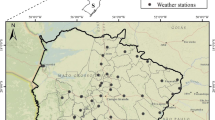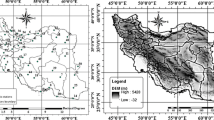Abstract
The global mean surface temperature may rise by about 0.3° C per decade during the next few decades as a result of anthropogenic greenhouse gas emissions in the earth's atmosphere. The data generated in the greenhouse warming simulations (Business-as-Usual scenario of IPCC) with the climate models developed at Max Planck Institute for Meteorology, Hamburg have been used to assess future plausible hydrological scenario for the South Asian region. The model results indicate enhanced surface warming (2.7°C for summer and 3.6°C for winter) over the land reginos of South Asia during the next hundred years. While there is no significant change in the precipitation over most of the land regions during winter, substantial increase in precipitation is likely to occur during summer. As a result, an increase in soil moisture is likely over central India, Bangladesh and South China during summer but a statistically significant decline in soil moisture is expected over central China in winter. A moderate decrease in surface runoff may occur over large areas of central China during winter while the flood prone areas of NE-India, Bangladesh and South China are likely to have an increase in surface runoff during summer by the end of next century.
Similar content being viewed by others
References
Cubasch, U., K. Hasselmann, H. Hock, E. Maier-Reimer, U. Mikolajewicz, B. D. Santer and R. Sausen (1992), Time-dependent greenhouse warming computations with a coupled ocean-atmosphere model,Clim. Dyn.,8: 55–69.
IPCC, (1990), Climate Change: The IPCC Scientific Assessment (Eds. J. T. Houghton, G. J. Jenkins and J. J. Ephraums), Cambridge University Press, 365 pp.
IPCC, (1992), Climate Change 1992-The Supplementary Report to the IPCC Scientific Assessment (Eds. J. T. Houghton, B. A. Callander and S. K. Varney), Cambridge University Press, 200 pp.
Lal, M. (1993), Simulation of present-day monsoon rainfall climatology with ECHAM models: Impact of physical parameterization and resolution, CAS/JSC Working Group Report No. 18, WMO/TD No. 533, January 1993, p. 4. 18–4.20.
Lal, M., U. Cubasch and B. D. Santer (1993), Greenhouse Gas Increases and monsoon climate, Chapter 7 in Global Warming: Concern for Tomorrow, Tata McGraw Hills Publishing Co. Ltd. New Delhi (Ed. M. Lai), 92–117.
Lal, M and S. Chander (1993), Potential Impact of Greenhouse Warming on the Water Resources of the Indian Subcontinent,Jr. Environ. Hydrol. (in press).
Mintz, Y. and V. Serafini (1981), Global field of soil moisture and land surface evapotranspiration, NASA Goddard Flight Centre, Tech. Memo. 8397, Research Review 3, 1980–1981,178–180.
Mintz, Y. and V. Serafini (1989), Global monthly climatology of soil moisture and water balance, LMD Internal Note No. 148, Ecole Polytechnique, Palaiseau (Paris).
MPI (1992), The ECHAM3 Atmosphere Model Documentation, Report No. 7 (Ed. Modellbetreuungsgruppe, DKRZ Hamburg), 185 pp.
Perlwitz, J., U. Cubasch and E. Roeckner (1993), Time-slice climate change experiments, CAS / JSC Working Group Report No. 18, WMO / TD No. 533, January 1993, p.9.9.
Willmott, C. J., C. M. Rowe and Y. Mintz (1985), Climatology of the terrestrial seasonal water cycle,J. Climatol,5: 589–606.
Author information
Authors and Affiliations
Rights and permissions
About this article
Cite this article
Lal, M. Water resources of the South Asian region in a warmer atmosphere. Adv. Atmos. Sci. 11, 239–246 (1994). https://doi.org/10.1007/BF02666550
Received:
Revised:
Issue Date:
DOI: https://doi.org/10.1007/BF02666550




